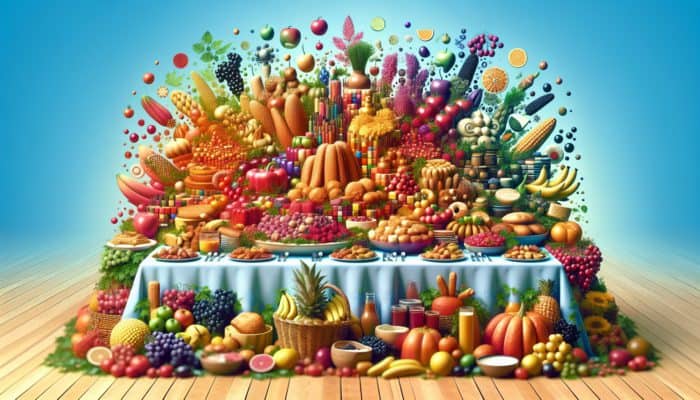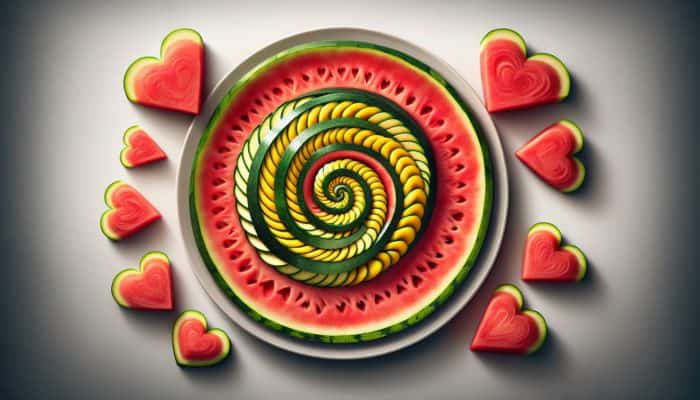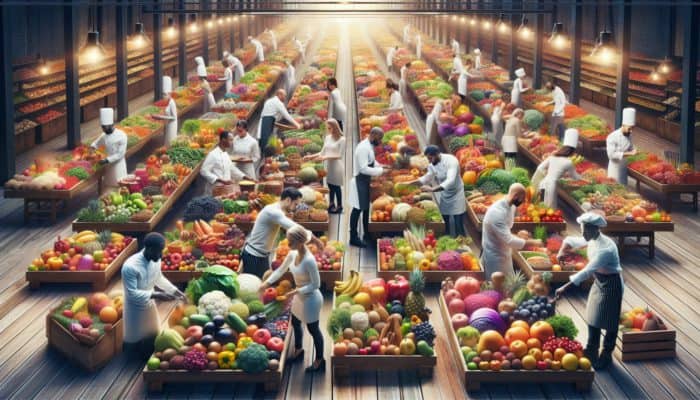Choosing Vibrant Ingredients for Stunning Food Displays
Selecting the Freshest Produce for Maximum Appeal

Top Tricks for Colourful Food Displays: When crafting stunning food displays, selecting the right ingredients is crucial. Opting for fresh fruits and vegetables not only guarantees vibrant colours but also maximises flavour and nutrition. During your shopping excursions, prioritise items that are in season, as they generally offer peak quality and taste. For instance, ripe strawberries provide a brilliant burst of red, while fresh green asparagus contributes a satisfying crunch. The visual allure of fresh produce can elevate even the simplest dish into a captivating work of art, enticing guests and enhancing their overall dining experience.
Additionally, take note of the diverse range of colours and shapes available. A vibrant mix of bell peppers in shades of red, yellow, and green can create an eye-catching display, while unique varieties such as purple carrots or striped heirloom tomatoes introduce an element of surprise. Sourcing produce from local farmers' markets not only supports local agriculture but also provides fresher ingredients that are often more vibrant than their supermarket equivalents. Combining various textures, such as the creamy smoothness of avocado with the crispness of radishes, enhances the sensory experience, making your food display not only visually appealing but also utterly inviting to taste.
In planning your food display, it’s important to consider how the colours of your ingredients will interact. Using complementary colours can create striking contrasts, while analogous colours can evoke a soothing effect. For example, a salad featuring deep purple cabbage, bright orange carrots, and crisp green lettuce creates a visual feast that beckons diners. Ultimately, the foundation of any stunning food display resides in the meticulous selection of fresh, colourful produce.
Elevating Your Dishes with Edible Flowers
Incorporating edible flowers into your food presentations can take them to an entirely new level of sophistication. Flowers like nasturtiums and violets not only introduce vibrant colours but also bring unique flavours that can enhance your culinary creations. For example, nasturtiums impart a peppery taste, making them an exciting addition to salads and garnishes, while violets can offer a hint of sweetness to desserts.
When choosing edible flowers, it's essential to ensure their source and preparation are safe. Opt for organic flowers that are free from pesticides. Many chefs are turning to urban gardens and local allotments for their edible blooms, ensuring fresh and safe ingredients. Alternatively, you can cultivate your garden of edible flowers, incorporating varieties like calendula, which has a bright yellow hue and a slightly tangy flavour. This practice not only guarantees freshness but also allows for a unique personal touch in your presentations.
When arranging edible flowers, think about how they can complement the overall theme of your dish. A platter of vibrant fruit can be beautifully adorned with scattered blossoms, creating an enchanting visual display. You can also use larger flowers as centrepieces on individual plates, providing a stunning focal point. By integrating these botanical beauties, you can transform even the simplest dish into an extraordinary culinary experience that delights the senses.
Enhancing Your Dishes with Natural Dyes
The increasing trend of using natural dyes in food preparation not only adds visual allure but also aligns with the growing demand for healthier, more natural ingredients. Derived from colourful produce like beetroot, turmeric, and spirulina, natural dyes create breathtaking visual impacts without the harsh chemicals associated with synthetic options. Imagine fluffy pancakes tinted a beautiful golden yellow with turmeric or pastel-hued frosting made with vibrant beet juice. These choices are not only visually striking but also contribute to the nutritional value of your dishes.
For those eager to explore this option, the process typically involves extracting pigments from the source ingredients. For instance, boiling beetroot and reducing the liquid yields a deep magenta dye perfect for icings or desserts. Similarly, turmeric can be incorporated into both sweet and savoury dishes, providing a warm hue and subtle earthiness. Spirulina, a blue-green algae, offers a vibrant teal colour, particularly when used in smoothies or desserts.
Incorporating natural dyes into your culinary repertoire not only enhances the aesthetic qualities of your dishes but also aligns with a commitment to a healthier lifestyle. As consumers become increasingly conscious of food sources and ingredients, utilising natural dyes demonstrates a commitment to quality and wellness. The outcome is food that is not only visually captivating but also a true feast for the palate, embodying the principle of eating with both your eyes and your heart.
Maximising Impact Through Food Arrangement

Creating Balance with Colours and Textures
Crafting a visually appealing food display necessitates a careful balance of colours and textures. The interplay between vibrant hues and varied textures can engage diners, making the presentation irresistible. Begin by selecting a colour palette that resonates with the dish or theme. For example, a Mediterranean spread can feature the deep reds of roasted peppers alongside the creamy whites of tzatziki. At the same time, a tropical fruit platter might display the bright yellows of mango against the lush greens of kiwi.
Texture is equally crucial; the contrast between creamy, crunchy, and juicy elements can create a multisensory experience. Picture a salad where crisp lettuce mingles with creamy avocado and crunchy nuts. This combination not only tantalises the taste buds but also captivates the eyes, inviting guests to indulge. Layering ingredients—such as vibrant vegetables over smooth dips—adds a dynamic effect that significantly enhances visual interest.
To achieve this balance, consider the arrangement of your display. Grouping similar items can foster a cohesive appearance, while scattering contrasting colours can spark excitement. A charcuterie board, for example, can showcase an array of cheeses, meats, fruits, and crackers, ensuring that each element stands out while contributing to a harmonious overall presentation. By focusing on the balance of colours and textures, you’re not just serving food; you’re crafting an engaging visual narrative that tells a story with every bite.
Incorporating Height and Depth for Visual Interest
Integrating height and depth into your food displays is essential for creating a dynamic and engaging presentation. Using tiered platters or stands adds dimension to your arrangement, allowing each element to shine while preventing a flat, uninspired display. This technique proves particularly effective for events such as weddings or parties, where the visual impact can significantly enhance the overall ambience.
When selecting your serveware, opt for pieces with varying heights to create visual interest. This could involve placing cupcakes on a raised pedestal while positioning fruits at a lower level on the table. This contrast not only draws the eye but also encourages guests to explore the spread. Consider using glass domes to elevate smaller items, transforming them into focal points in your display.
In addition to physical height, consider the depth of your layout. Layering ingredients, such as placing bowls beneath platters or creating overlapping arrangements, can add to the visual intrigue. For instance, a seafood platter can feature shrimp stacked atop a bed of crushed ice, with elegant lemon wedges and herbs cascading around it. This depth not only enhances beauty but also implies abundance, enticing diners to indulge. By effectively utilising height and depth, you can turn a simple food arrangement into a breathtaking masterpiece that excites the senses.
Crafting Patterns and Shapes for Enhanced Aesthetics

Utilising patterns and shapes can serve as powerful tools in food presentation, guiding the viewer's eye and creating an artistic flair. Organising food in specific patterns or shapes can heighten the aesthetic appeal of your display, making it more inviting. The geometry of culinary art is fascinating; consider how a circular arrangement can echo the shape of a plate, or how a spiral of ingredients can draw attention.
One effective technique is to create repeating patterns using similarly coloured items. For example, alternating slices of zucchini and yellow squash in a circular pattern can yield a vibrant and visually stimulating effect. Alternatively, arranging fruits in a gradient of colours can evoke a sense of joy and playfulness. Shapes can also communicate themes; for instance, heart-shaped watermelon pieces can convey romance during a wedding or anniversary celebration.
Moreover, consider using negative space strategically. Allowing areas of the platter to remain empty can highlight the present items, drawing attention to their colours and shapes. A minimalist approach, where simple shapes like triangles, circles, or squares are employed, can create a sophisticated look that resonates with modern aesthetics. By implementing patterns and shapes, you not only capture the visual interest of your audience but also elevate your food display from ordinary to extraordinary.
Enhancing Displays with Thoughtful Garnishes
Choosing Complementary Garnishes for Visual Appeal
Enhancing your food displays with the right garnishes can significantly elevate the overall visual impact of your dishes. A garnish acts as the finishing touch, transforming a simple plate into an enticing work of art. When selecting garnishes, aim for colours and textures that complement the main dish. For instance, a vibrant green parsley sprig can add freshness to a rich beef stew, while thinly sliced radishes can inject a pop of colour into a sushi platter.
It’s also crucial to select garnishes that align with the flavours of the dish. A sprinkle of pomegranate seeds atop a creamy tahini dip adds colour along with a delightful burst of sweetness and crunch. Similarly, a drizzle of balsamic reduction can enhance the visual appeal of a caprese salad while enriching its flavour profile. The key is to ensure that your garnishes are not merely decorative but enhance the overall experience of the dish.
Experimenting with various garnishes can yield stunning results. Edible microgreens, for example, provide height and an exquisite visual element, while slices of citrus can introduce a refreshing touch. The objective is to create a visually harmonious presentation where garnishes feel like an intentional part of the dish rather than an afterthought. By carefully selecting complementary garnishes, you can elevate your food displays, ensuring they are as delightful to behold as they are to consume.
Enhancing Color and Flavor with Fresh Herbs
Incorporating fresh herbs into your food displays can significantly boost both colour and flavour, making them indispensable for culinary presentations. Herbs like basil, mint, and dill not only add vibrant green notes but also introduce aromatic flavours that enhance the overall dish. Use herbs to create a fresh, lively backdrop for your presentation; a sprig of rosemary can provide a stunning contrast against a plate of roasted vegetables.
When using herbs, consider their arrangement carefully. Large leaves can form a base for other ingredients, or finely chopped herbs can be sprinkled over a dish to add elegance and refinement. For a Mediterranean-themed platter, a handful of fresh parsley can create a beautiful contrast against the vibrant colours of roasted peppers and olives. The aromatic properties of herbs also engage the senses, enticing diners to indulge even before they take a bite.
Experimenting with various herbs allows you to create unique flavour pairings that can enhance your food presentations. A mint garnish on a chocolate dessert can surprise guests with a refreshing twist, while a sprinkle of dill over fish adds a gourmet touch. By thoughtfully incorporating herbs into your displays, you create not just visually appealing dishes but also multi-dimensional flavours that resonate with your audience.
Using Citrus Zest for Vibrant Accents
Citrus zest is a simple yet effective method to elevate your food displays with vibrant colour and a refreshing tang. The bright hues of lemon, lime, and orange zest can infuse life into any dish, transforming ordinary presentations into eye-catching masterpieces. For instance, a sprinkle of lemon zest over a creamy pasta dish not only enhances visual appeal but also adds a zesty kick that brightens the entire dish.
Utilising citrus zest goes beyond aesthetics; it also enhances flavour. The natural oils in the zest provide an aromatic element that can elevate the entire dining experience. Consider using lime zest on fish tacos to impart a fresh, zesty note, or orange zest on top of a chocolate cake to create a sophisticated flavour profile. The combination of colours and flavours can tantalise the taste buds, making your dishes more memorable.
In addition to its culinary uses, citrus zest serves as an effective garnish that draws the eye. A delicate sprinkle over a salad or dessert creates a captivating visual contrast, inviting guests to explore the flavours on their plates. Experimenting with citrus zest allows for creative freedom, enabling chefs to craft presentations that are not only beautiful but also packed with flavour. By incorporating this vibrant addition into your displays, you can ensure your food stands out enticingly and deliciously.
Revisiting the Benefits of Edible Flowers
As previously mentioned, edible flowers can be a delightful addition to your food displays, enriching both appearance and flavour. The incorporation of these vibrant blooms can transform ordinary dishes into extraordinary visual feasts. Flowers like pansies or borage not only add bursts of colour but also provide subtle flavour nuances that complement various dishes.
When selecting edible flowers, consider their colours, shapes, and sizes to create a cohesive and visually appealing arrangement. A mix of different flowers can add complexity to your display, while choosing a single type can create an elegant uniformity. Using larger flowers, such as hibiscus, can serve as eye-catching centrepieces, while smaller blossoms can be scattered throughout a dish for added charm.
Integrating these flowers into your culinary creations can also communicate themes or sentiments. For instance, a vibrant flower arrangement can evoke the image of a summertime picnic, while delicate blooms can signify elegance at a formal dinner. The versatility of edible flowers enables creative presentations that perfectly resonate with the occasion. By thoughtfully incorporating edible flowers into your food displays, you create a stunning visual narrative that enhances the overall dining experience.
Optimising Displays with Lighting and Backdrops
Selecting Ideal Lighting for Food Presentation
The influence of lighting on food presentation cannot be overstated, as it plays a crucial role in how colours and textures are perceived. Soft, natural lighting enhances the vibrant colours of your food, making it appear more appealing and appetising. When setting up a display, consider the time of day and available light sources. Daylight can provide a gentle glow, while dim indoor lighting may require additional illumination to showcase your culinary creations effectively.
Utilising reflectors or white surfaces around your display can also help bounce light and enhance its overall appearance. For instance, placing a mirror beneath a tiered cake can create a stunning effect that amplifies the visual impact. Additionally, consider the direction of the light; side lighting can produce beautiful shadows that add depth and texture to your arrangements.
Experimentation is key when it comes to lighting your food displays. Use warm tones to create a cozy atmosphere for comfort foods, or opt for cooler tones for modern, sleek presentations. Avoid harsh overhead lights that may wash out colours or create unflattering shadows. Instead, aim for a soft, diffused glow that highlights the beauty of your dishes. By carefully selecting the right lighting, you can elevate your food displays from ordinary to extraordinary, captivating your audience from the moment they arrive.
Choosing Appropriate Backdrops for Visual Appeal
The choice of backdrop is equally important for effectively showcasing your food displays. Neutral tones generally work best, as they allow the colours of the food to stand out without clashing. A simple white tablecloth or wooden platter can create a rustic, inviting atmosphere that emphasises the vibrant hues of your dishes. Conversely, a bold colour can make specific elements pop while setting the mood for the event.
When selecting a backdrop, consider the theme of your gathering. For a beach-themed party, a sandy-coloured tablecloth might evoke a relaxed vibe, while a bright, patterned fabric can add a festive touch to a celebratory occasion. The backdrop should enhance, not overshadow, the food. By keeping it simple yet intentional, you create a cohesive visual narrative that draws attention to the culinary delights awaiting your guests.
Additionally, incorporating varied textures can add interest to your backdrop. A rustic wooden board can infuse warmth into an elegant cheese display, while a smooth marble surface can enhance a modern dessert spread. The key is to find a balance where the backdrop complements the food while contributing to the overall aesthetic. By carefully selecting your backdrops, you create an inviting and visually appealing environment that encourages guests to indulge in your offerings.
Positioning Food for Optimal Light Exposure
Once you have chosen the right lighting and backdrop, it’s time to focus on positioning your food for optimal light exposure. The arrangement of dishes can dramatically affect their perception. Arrange your food to catch the light beautifully, highlighting its colours and textures. For instance, shiny glazes and glossy sauces will reflect light, creating a tantalising visual effect that draws diners closer.
Consider the layout of your display; avoid overcrowding and ensure each dish has enough space to breathe. A well-spaced arrangement not only promotes airflow but also allows light to reach each dish evenly. Elevating certain items can create a dramatic effect, allowing for better light exposure. For example, a cake on a pedestal can reflect light beautifully, while fruits arranged in a cascading pattern create dynamic visual flow.
Moreover, keep in mind the angles from which your guests will view the display—position items at varying heights and orientations to ensure that every element is attractive from multiple perspectives. By thoughtfully positioning your food to maximise light exposure, you create a stunning visual presentation that captivates and excites, making every dish irresistible.
Enhancing Food Displays with Creative Serveware
Matching Serveware to Complement Food Colours
The choice of serveware can significantly influence the overall aesthetic of your food displays. Matching your plates and bowls to the colours of the food can create a cohesive look that enhances the visual appeal of your dishes. For instance, using vibrant blue plates can complement a fresh seafood platter, while earthy-toned ceramics can enhance the natural beauty of a vegetable medley.
Consider the theme and mood of your event when selecting serveware. For a formal gathering, elegant white china can provide a classic touch, allowing the food to take centre stage. Conversely, for a casual picnic, colourful enamelware can evoke a fun, relaxed atmosphere. The key is to ensure that your serveware not only complements the food but also fits the overall aesthetic of the occasion.
Additionally, using contrasting colours can create a striking visual impact. Pairing bright dishes with darker backgrounds can make the food appear even more vibrant. Experimenting with varying textures and finishes can also add depth to your display. A glossy plate might reflect light beautifully, while a matte finish can create a softer, understated elegance. By thoughtfully choosing serveware that matches or contrasts with your food colours, you enhance the overall presentation, inviting guests to enjoy the culinary delights before them.
Utilising Transparent Containers for Visual Clarity
Transparent containers are a powerful tool for showcasing the vibrant colours of your food. Whether it’s a glass jar filled with colourful salad ingredients or a clear bowl displaying an array of fruits, transparency allows diners to appreciate the beauty of the ingredients inside. The visual clarity of glass or acrylic containers can create an inviting presentation that encourages guests to indulge.
When using transparent containers, consider layering the ingredients to create a visually appealing effect. For example, a parfait made with alternating layers of yogurt, granola, and berries can transform a simple dish into a stunning masterpiece. The vibrant colours and textures will be on full display, enticing guests with each layer. Moreover, transparent serveware can promote a sense of freshness and lightness, making your food feel more wholesome.
Utilising clear containers also allows for experimentation with different shapes and sizes, adding further interest to your display. Tall, narrow vases can create an elegant statement for floral arrangements, while wide bowls can serve as communal serving dishes for salads or pasta. By incorporating transparent containers into your food arrangements, you create an enticing visual experience that highlights the beauty of your ingredients, making your dishes even more appetising.
Experimenting with Colourful Tableware for Added Interest
Incorporating colourful tableware into your food displays can enhance their visual appeal, adding an extra layer of interest and excitement. Brightly coloured plates, bowls, and utensils can invigorate your presentation, making it more engaging for guests. For example, a set of vibrant orange plates can create a warm, inviting atmosphere for a summer barbecue. At the same time, colourful patterned bowls can evoke a casual, fun vibe for a brunch gathering.
When experimenting with colourful tableware, consider how the colours of the dishes interact with the food. A bright red plate can complement a salad with strawberries, while a turquoise bowl can enhance a dish of shrimp cocktail. By thoughtfully coordinating colours, you create a cohesive, visually appealing presentation that captures attention.
Additionally, mixing and matching different patterns and textures can create a dynamic and playful display. Layering floral and geometric prints can add depth to your arrangements, making them feel more vibrant and alive. However, ensure that the combinations do not clash; finding the right balance is key to achieving a polished look. By embracing colourful tableware, you can create food displays that not only look beautiful but also reflect the personality of your event, inviting guests to savour every moment.
Mixing Patterns and Textures for Engaging Displays
Using a variety of patterns and textures in your serveware can add visual interest and dynamism to your food displays. Mixing different materials, such as ceramic, glass, and wood, can create an engaging and eclectic presentation. For example, a rustic wooden board combined with sleek glass bowls juxtaposes warmth and modernity, enhancing the overall aesthetic of your spread.
Consider the patterns on your serveware as well. Stripes, florals, and geometric designs can add layers of complexity to your displays. When selecting patterns, aim for those that harmonise with your food to create a cohesive look. A floral-patterned tablecloth can bring a garden-like feel to a summer picnic, while a geometric plate can lend a contemporary touch to a modern dining experience.
Incorporating various textures also plays a crucial role in enhancing the presentation of your food. Combining smooth, glossy plates with rough, textured bowls can create a visually captivating contrast, drawing guests in. Additionally, consider the tactile experience; using different materials can invite diners to engage more fully with the food. By skillfully mixing patterns and textures, you create a rich and layered presentation that captivates the eyes and tantalises the taste buds.
Curating Thematic Colour Schemes for Food Displays
Designing Monochromatic Displays for Elegant Simplicity
Monochromatic displays offer a sophisticated approach to food presentation, allowing for a cohesive and elegant aesthetic. By employing varying shades of a single colour, you can create depth and interest while maintaining a unified theme. Consider a display featuring different shades of green, from vibrant spinach and avocado to pale green cucumbers and herbs. You can create a visually striking platter that feels fresh and harmonious.
The key to successful monochromatic displays lies in the careful selection of items that vary in texture and shape. A mix of smooth, crisp, and creamy elements can enhance the overall sensory experience. For instance, a white-themed dessert table featuring coconut mousse, vanilla cream puffs, and white chocolate truffles can create an ethereal, luxurious atmosphere that entices guests.
When designing a monochromatic display, consider how the light interacts with your chosen colours. Different shades can reflect light in unique ways, adding depth and dimension to your arrangement. The result is a cohesive presentation that feels intentional and curated, inviting guests to appreciate both the beauty and intricacy of the display. By embracing monochromatic themes, you can create a striking visual narrative that leaves a lasting impression.
Creating Striking Visuals with Complementary Colours
Using complementary colours, or colours that sit opposite each other on the colour wheel, can create striking visual contrasts that capture attention. This technique is particularly effective in food displays, where the dynamic interplay of colours can enhance the appeal of each dish. For example, pairing deep purple eggplant with bright yellow corn creates a vibrant and inviting arrangement that excites the senses.
When employing complementary colours, consider how they can enhance flavour experiences as well. Colours often evoke emotional responses; warm tones, such as red and orange, can stimulate appetite, while cool tones, like blue and green, can foster a calming effect. By thoughtfully selecting complementary colours, you can not only enhance the visual appeal of your dishes but also create an atmosphere that resonates with your audience.
Experimenting with different combinations can lead to captivating results. A salad featuring vibrant greens, reds, and yellows can create a rainbow effect that tantalises diners. Plating is essential; consider using contrasting colours for your serveware to highlight the food even further. By effectively using complementary colours, you can craft food displays that are visually stunning and evoke powerful emotional responses, making your presentations truly unforgettable.
Emphasising Seasonal Colours in Your Displays
Embracing seasonal colours in your food displays can evoke the essence of the time of year, creating a thematic connection that resonates with guests. For instance, autumn presentations might feature rich oranges, browns, and deep reds, while spring displays can incorporate bright pastels and fresh greens. By aligning your food colours with the seasons, you create a natural, organic feel that enhances the overall dining experience.
Seasonal colours can be incorporated through the careful selection of ingredients. In the summer, consider using vibrant tomatoes, lush greens, and bright berries to reflect the season's bounty. In winter, root vegetables, citrus fruits, and hearty greens can create a warm and inviting atmosphere. By focusing on seasonal produce, you not only enhance the visual appeal of your dishes but also promote sustainability and local sourcing.
Additionally, consider how seasonal colour palettes can influence the choice of serveware and decorations. Warm wooden platters can create a rustic feel in autumn, while bright ceramic dishes can evoke a cheerful vibe in spring. By harmonising your food displays with seasonal colours, you create a cohesive experience that resonates with your audience, making every gathering feel special and memorable.
Frequently Asked Questions About Food Presentation
What are the best ingredients for creating colourful food displays?
Fresh produce, such as vibrant fruits and vegetables, along with edible flowers, can significantly enhance the colour palette of any food display.
How can I balance colours and textures in my food presentations?
Aim to use a variety of colours and textures, ensuring that they complement each other. For example, pair smooth ingredients with crunchy ones and utilise contrasting colours for visual interest.
What are some tips for arranging food to maximise its impact?
Consider using height and depth with tiered platters and varying arrangements, as well as creating patterns with food items to enhance visual appeal.
How do garnishes enhance food displays?
Garnishes not only add visual appeal but can also enhance flavour. Choose complementary garnishes that reflect the main dish’s colours and flavours for the best effect.
What types of lighting work best for food displays?
Soft, natural lighting is ideal for highlighting the vibrant colours of your food. Avoid harsh lighting that can wash out colours and create unflattering shadows.
How can I use tableware to enhance my food displays?
Select colourful or patterned tableware that complements or contrasts with the food. Mixing different textures and patterns can also add visual interest to your arrangement.
What are some effective ways to create thematic colour schemes?
Consider using monochromatic displays, complementary colours, or seasonal colour palettes to create a cohesive theme that resonates with the occasion.
How can I make my food displays more visually appealing and engaging?
Incorporate height and depth, use varied textures and colours, and experiment with different arrangements to create a dynamic and visually appealing presentation.
What role do edible flowers play in food displays?
Edible flowers add vibrant colour and unique flavours to food presentations, enhancing both visual appeal and the overall flavour profile of dishes.
How can I incorporate natural dyes in my food presentations?
Use natural ingredients like beetroot, turmeric, and spirulina to create beautiful colour variations in your dishes, making them visually appealing while remaining healthy.



Your insights on selecting vibrant ingredients for food displays really resonate with me, particularly the emphasis on seasonal produce. I’ve found that shopping locally for fruits and vegetables not only guarantees freshness but also supports local farmers, which contributes to a more sustainable food system. For instance, I recently attended a community farmers’ market where I discovered heirloom tomatoes in various hues—from deep purple to bright yellow. The diversity in both color and flavor was astounding and made the dishes I prepared feel like a culinary adventure.
Your insights on the importance of selecting vibrant ingredients truly resonate with me, especially in a culinary landscape that celebrates not only taste but also visual appeal. The connection between color, freshness, and presentation can’t be overstated—it can transform an ordinary meal into something extraordinary. I’ve often found that when I focus on in-season produce, not only does the aesthetic palette explode with vibrant hues, but the flavors are also at their peak, making every bite a delightful experience.
You’ve really captured the essence of what makes cooking such a joy. It’s amazing how in-season produce can not only brighten up our plates but also elevate the overall flavor experience. When you think about it, the colors in a dish tell a story about freshness and the best nature has to offer.
“I completely agree! If you’re looking to elevate your culinary creations even further, check out this curated selection of seasonal produce that bursts with color and flavor.”
https://cookinggods.com/SmoothieRecipes